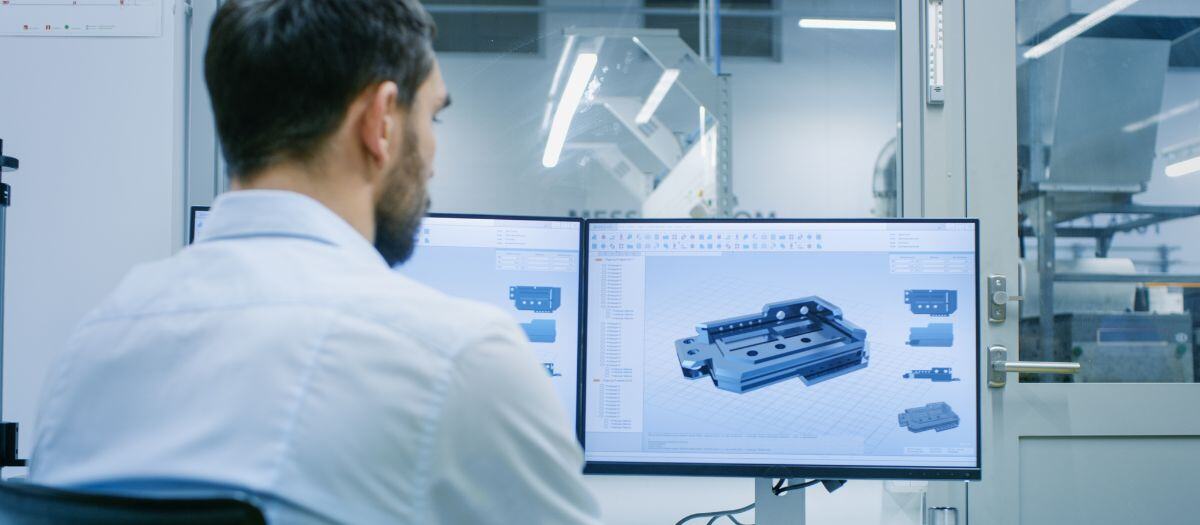Converting theoretical designs into practical, operational models remains a persistent challenge in control engineering. Precision is critical, and even minor design errors can lead to significant operational failures.
CAD software addresses this need effectively. Leveraging cutting-edge CAD tools helps professionals visualize and employ complex engineering principles.
CAD tools have significantly progressed over the years. The market was valued at $9.5 million in 2022, and it’s projected to reach $13.5 million by 2028, growing at a compound annual growth rate (CAGR) of 6.13% during this period. This data highlights the advancement of CAD technologies across various industries (e.g., automation, manufacturing, and robotics).
However, adopting modern CAD tools is just the starting point. Control engineers must leverage integration, customization, and ongoing education to truly maximize productivity. In this article, we’ll discuss how prioritizing these strategies enhances accuracy and speed when creating detailed, accurate models.
Ensure Effective Integration of CAD Tools with Other Systems
Integrating CAD tools with other software systems can significantly enhance the productivity and accuracy of control engineers.
Reducing Manual Data Entry and Errors
Integration with other software helps organizations drastically reduce manual data entry, which in turn cuts down on errors and maintains consistency across various platforms.
Effective integration not only streamlines workflows but also leads to significant time and cost savings by reducing the need to toggle between applications. Having advanced yet underutilized tools inadvertently creates roadblocks.
Research shows that workers waste an average of 4 hours a week jumping between various work apps. It isn’t just about the physical act of pressing keys; adjusting to the context and purpose after each switch takes time.
Maintaining Data Consistency
Maintaining data consistency across platforms prevents information silos, promoting better decision-making. Consistent data ensures that all team members have access to the same information, which is critical for making informed decisions quickly and accurately.
Enhancing Collaboration
Integration supports a collaborative project environment by enabling team members to access the most up-to-date data, which is crucial for maintaining the accuracy and efficiency of project outcomes. By ensuring everyone has access to the latest information, teams can work more cohesively, leading to faster project completion times and higher-quality results.
Common Challenges With Company-Wide System Integration
However, integrating CAD tools with other systems can present several challenges. Here are some common roadblocks you might encounter during the integration process:
Fragmented Data Flows
Fragmented data flows between CAD and other project management tools can lead to errors and inefficiencies. While documents remain accessible individually, the lack of organization makes them harder to manage and analyze, particularly when collaborating with third parties.
To address this, Autodesk Product Management Solutions can be used to facilitate real-time data exchange between systems. Ensuring that data is updated simultaneously across all platforms reduces the risk of discrepancies and improves overall workflow efficiency.
Compatibility Issues
Compatibility issues with legacy systems not designed to interact with modern CAD tools present several problems. Data may not transfer correctly, leading to errors or loss of information. Engineers ultimately spend time manually correcting discrepancies.
To minimize these types of errors, conduct system compatibility assessments and upgrade where and when necessary to ensure smooth integration. Replace outdated software and implement middleware solutions to facilitate better communication.
Lack of Automation Knowledge
Although experts in their respective fields, control engineers sometimes lack expertise in automating data transfers between systems, which results in manual and error-prone processes. The best approach is to partner with a certified service provider that offers CAD training and software support.
Standardize CAD Practices Across Projects
Without standardized CAD practices, different teams may produce inconsistent output, jeopardizing project integrity. Erratic designs can cause misaligned components and fitting issues, while increased errors become difficult to pinpoint. Even minor revisions might add up to significant losses over time.
The Importance of Having Standardized Practices
To ensure consistent, precise, and efficient output across projects, create standardized CAD practices.
When CAD practices are standardized, all team members use the same templates, symbols, and drawing conventions. This uniformity ensures that everyone interprets the designs the same way, which is crucial for large teams where multiple people may work on different aspects of the same project.
Standardization also ensures that every project adheres to the same quality and precision standards. This consistency is vital for maintaining high-quality output and avoiding discrepancies that could compromise project integrity.
Moreover, a clear, standardized set of practices and tools accelerates employee onboarding. Instead of learning the nuances of a particular team’s approach, they can focus on mastering a single, well-documented set of procedures that apply universally across the team, which cuts training time and helps new hires hit the ground running.
Common Issues When Standardizing CAD Practices
Although implementing standardized CAD practices enables teams to work more cohesively and reduce errors, there’s a major roadblock: collaboration.
Enforcing a new set of CAD practices can prove challenging when teams already have pre-existing workflows, which is particularly difficult with tenured control engineers who are accustomed to their familiar standards. To overcome aversion, it's essential to convincingly highlight the potential benefits of uniform guidelines.
Introduce standardization gradually and emphasize its long-term benefits through comprehensive training sessions. Explain how consistent designs across teams benefit the company and also reduce individual workloads. Emphasizing the efficiency, accuracy, and collaborative advantages of standardized practices can help gain acceptance and ensure a smoother transition.
Develop Skills Continuously in CAD Technologies
As technology evolves, new features and tools emerge that can make control engineers’ work more precise and efficient. Staying current with the latest advancements in CAD software enhances individual capabilities and also benefits the organization by improving design quality and streamlining engineering processes. Embracing innovation in CAD tools ensures that engineers can leverage the most effective methods for their projects.
Fostering an excellent learning culture within a team promotes knowledge-sharing and collaboration. Encouraging team members to acquire new skills and share their knowledge boosts overall morale and job satisfaction. This continuous development leads to a more competent and cohesive team, driving better project outcomes and organizational success.
Common Roadblocks to Ongoing Learning
The biggest challenge is keeping up with rapid technological advancements, which can quickly outpace current skill levels. With new developments emerging daily, it's impossible for busy engineers to stay updated while managing core responsibilities.
Instead, establish a continuous learning culture through regular workshops and certified courses. This proactive approach maintains proficiency and improves project outcomes, effectively leveraging the latest technological advancements without disrupting primary duties.
How Hagerman Can Help You Maximize CAD Tool Efficiency for Control Engineers
Control engineers must embrace the latest CAD developments to help them create accurate, detailed models of complex systems. Modernized practices reduce the risk of output inconsistency. They also facilitate automated data transfer across systems, making it easier for authorized users to pull engineering documents in real-time.
If you need help utilizing modern CAD tools, contact the experts at Hagerman. We offer specialized CAD training and custom-tailored CAD solutions for control engineers. Our field instructors understand the unique challenges that various industries face. We guarantee a specialized solution that’ll help you overcome specific operational roadblocks, from missing as-built documents to inaccurate CAD models. Learn more about us today.
|
|





Comments